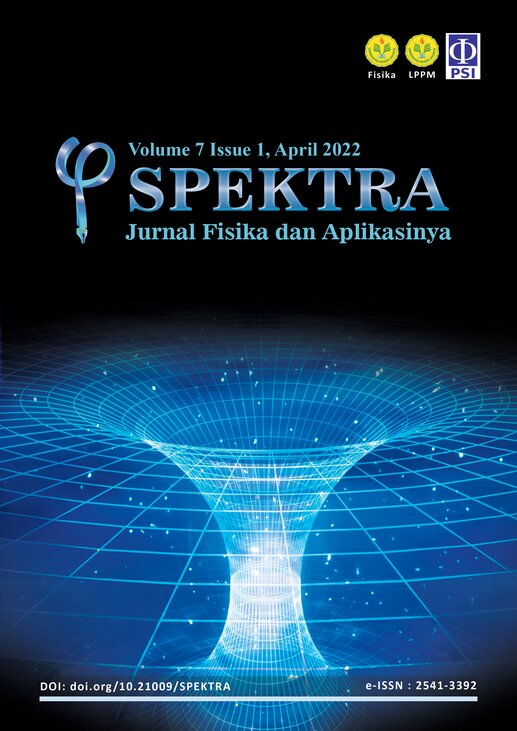STUDY OF CRUSTAL STRUCTURE OF THE FLORES ISLAND USING RECEIVER FUNCTION METHOD
DOI:
https://doi.org/10.21009/SPEKTRA.071.01Keywords:
Moho, receiver function, non-linear algorithm neighbourhood inversionAbstract
Flores is an island located in the north of the East Nusa Tenggara region. Formed as a consequence of very complex tectonic setting that might cause relatively high level of seismic in the region. This study aims to characterize the crust structure based on the S wave velocity model, the Vp/Vs ratio, and crustal thickness beneath the station on Flores Island. This study was using receiver function analysis method of teleseismic earthquake data with magnitude criteria ≥ 6 and epicenter distance 30⁰-90⁰. Seismic signal recorded on broadband stations three components. This study was using LBFI station. Velocity model of S wave and Vp/Vs ratio determined by using the non-linear Neighbourhood Algorithm (NA) inversion. Furthermore, the velocity and Vp/Vs ratio models will be used to obtain the depth of the migration process of the amplitude of the receiver function to depth. From the results of processing the depth of the Moho layer on the island of Flores under the LBFI station was identified as 41 km. The existence of the slab can be identified quite well that is at depth about 110 to 140 km.
References
[2] W. B. Hamilton, “Tectonics of the Indonesian region,” US Govt. Print. Off., no. 1078, 1979.
[3] S. Syuhada et al., “Crustal Structure Along Sunda-Banda Arc Transition Zone from Teleseismic Receiver Functions,” Acta Geophys., vol. 64, no. 6, pp. 2020-2049, 2016.
[4] L. Zhu and H. Kanamori, “Moho depth variation in southern California from teleseismic receiver functions,” J. Geophys. Res. Solid Earth, vol. 105, no. B2, pp. 2969-2980, 2000.
[5] C. J. Ammon, “An overview of receiver-function analysis,” Home Page Ammon, 1997.
[6] F. J. Herrmann et al., “Frugal full-waveform inversion: From theory to a practical algorithm,” Lead. Edge, vol. 32, no. 9, pp. 1082-1092, 2013.
[7] L. P. Vinnik, “Detection of waves converted from P to SV in the mantle,” Phys. Earth Planet. Inter., vol. 15, no. 1, pp. 39-45, 1977.
[8] C. A. Langston, “Structure under Mount Rainier, Washington, inferred from teleseismic body waves,” J. Geophys. Res. Solid Earth, vol. 84, no. B9, pp. 4749-4762, 1979.
[9] C. J. Ammon, G. E. Randall, and G. Zandt, “On the nonuniqueness of receiver function inversions,” J. Geophys. Res. Solid Earth, vol. 95, no. B10, pp. 15303-15318, 1990.
[10] M. G. Bostock and M. D. Sacchi, “Deconvolution of teleseismic recordings for mantle structure,” Geophys. J. Int., vol. 129, no. 1, pp. 143-152, 1997.
[11] H. Prasetyo, “The Bali-Flores basin: geological transition from extensional to subsequent compressional deformation,” 1992.
Downloads
Published
How to Cite
Issue
Section
License
SPEKTRA: Jurnal Fisika dan Aplikasinya allow the author(s) to hold the copyright without restrictions and allow the author(s) to retain publishing rights without restrictions. SPEKTRA: Jurnal Fisika dan Aplikasinya CC-BY or an equivalent license as the optimal license for the publication, distribution, use, and reuse of scholarly work. In developing strategy and setting priorities, SPEKTRA: Jurnal Fisika dan Aplikasinya recognize that free access is better than priced access, libre access is better than free access, and libre under CC-BY or the equivalent is better than libre under more restrictive open licenses. We should achieve what we can when we can. We should not delay achieving free in order to achieve libre, and we should not stop with free when we can achieve libre.
 SPEKTRA: Jurnal Fisika dan Aplikasinya is licensed under a Creative Commons Attribution 4.0 International License.
SPEKTRA: Jurnal Fisika dan Aplikasinya is licensed under a Creative Commons Attribution 4.0 International License.
You are free to:
Share - copy and redistribute the material in any medium or format
Adapt - remix, transform, and build upon the material for any purpose, even commercially.
The licensor cannot revoke these freedoms as long as you follow the license terms.

 E-ISSN 2541-3392
E-ISSN 2541-3392  Focus & Scope
Focus & Scope  Editorial Team
Editorial Team  Reviewer Team
Reviewer Team  Author Guidelines
Author Guidelines  Article Template
Article Template  Author Fee
Author Fee  Publication Ethics
Publication Ethics  Plagiarism Policy
Plagiarism Policy  Open Access Policy
Open Access Policy  Peer Review Process
Peer Review Process  Retraction & Correction
Retraction & Correction  Licensing & Copyright
Licensing & Copyright  Archiving & Repository
Archiving & Repository  Contact
Contact  Mendeley
Mendeley 

